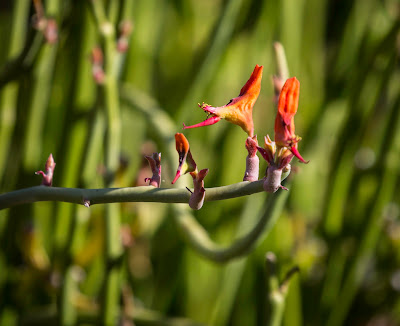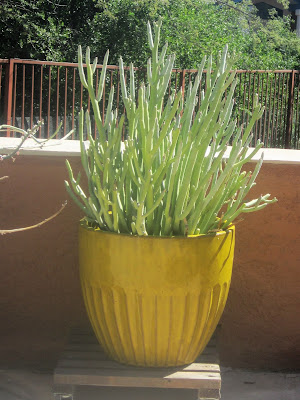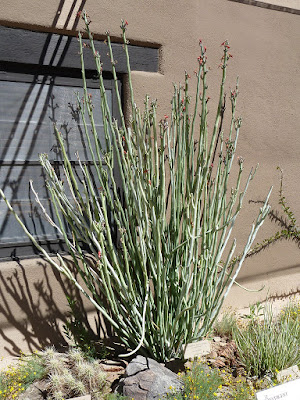Pedilanthus macrocarpus - Euphorbia lomelii is a perennial succulent plant that spreads by rhizomes to 7.5 high with thick succulent stems...
Pedilanthus macrocarpus, also called as Slipper plant, Ladies slipper, Gallito, Hexadenia macrocarpa, Tithymaloides macrocarpa, Tithymalus macrocarpus, and its scientific name Euphorbia lomelii, is a species of the genus Euphorbia. This species was described by Victor W. Steinmann in 2003.
IDENTIFY PEDILANTHUS MACROCARPUS - EUPHORBIA LOMELII
Pedilanthus macrocarpus is native to Mexico Northwest. It is found
growing in desert plains and hillsides, in sandy or loamy soils and rocky
areas of creosote-desert scrub communities in the Sonoran Desert of
northwestern Mexico, including central Baja California and Sonora.
Euphorbia lomelii is a perennial succulent plant that spreads by rhizomes to 7.5 high with thick succulent stems that are lime-green to silvery gray-green with a rough, waxy coating and contain a milky white sap that flows readily from even minor cuts to the stem. The stems are jointed and grow from the base of the plant forming dense clumps. The leaves are inconspicuous, green and often tinged with red, appear sporadically but drop from the plant during hot, dry conditions. Without leaves for most of the year, the plant photosynthesizes through its stems.
Slipper plant blooms in April to October from the tips of the stems, singly or in a small group. The unusual flowers are shaped like a slipper or a bird's head and are red to reddish-orange and yellow. The flowers are pollinated mainly by hummingbirds, with the Costa's hummingbird being the plant's primary pollinator in its natural habitat. Fruit is a round, horned 3-lobed capsule, or schizocarp, that has the same coloration as the flower.
PEDILANTHUS MACROCARPUS - EUPHORBIA LOMELII CARE AND CULTURE
Cultural information should only be used as a guide, and should be to be adapted to suit you. Your physical location; where you grow your plants, how much time you have to devote to their care, and many other factors, will need to be taken into account. Only then can you decide on the cultural methods that best suit you and your plants.
Light and exposure:
Pedilanthus macrocarpus prefers a lot of light. In hot climates, some afternoon shade can be helpful. In the cooler months and winter, they are just fine indoors with bright indirect light from a window. Immature plants (under two years old) do well with lots of bright, indirect sunlight.
Temperature:
Euphorbia lomelii are very hardy and can grow outdoors year-round in USDA hardiness zones 9-11, where daytime temperatures are almost always above. Mature plants can tolerate high temperatures during the day and desert-like drops in temperature overnight. They prefer hot, dry summers and cooler fall and winter months. The plant cannot tolerate temperatures lower than -4° C and you should never keep this plant in an area where the nighttime temperature falls lower than 5° C.
Soil:
Slipper plant need well-draining soil. A sandy soil with a slightly acidic to neutral soil pH is best, though most will do fine in slightly alkaline soil as well. Avoid clay-rich soil that is not well draining and promotes water-stagnation.
Potting and repot:
Pedilanthus macrocarpus will grow just fine in a garden, they can be grown in pots as well. When keeping this plant as a potted plant, use standard, packaged succulent or cactus mix as potting soil with pH level of 6.1-7.8. For a mixture of own preparation, take: 3 parts of coarse sand or perlite, 2 parts of turf ground, 2 parts humus, 2 parts peat. You can also add brick chips.
As the plant grows, it will need repotting. Don’t repot to frequently, instead wait until the plant is somewhat root-bound. Most of the time, repotting every two years is adequate. Springtime is the ideal time to repot and propagate the plant. To repot, ensure the soil is dry, then remove the pot and knock away the old soil, remove rotten and damaged roots. After treating any cuts with fungicide, place the plant in a new pot and backfill it with potting soil. As with a new cutting, make sure not to water a newly repotting plant for at least a week to avoid rotting its roots.
Watering:
Euphorbia lomelii is very sensitive to water therefore optimum irrigation should be provided during early stages of growth. The plants do not irrigate immediately after planting. Light watering should be done after 2-3 days of planting and there after irrigation should be given at 10-15 days interval up to one year. Fully established plantation requires light irrigation, 1-2 times a month is beneficial.
It is best to water thoroughly and then allow the soil to dry out completely before watering again. Make sure the plant has plenty of good drainage so it is never standing in water. Water extremely sparingly during the late fall and winter months. In the wintertime, it’s best to keep the plant dry.
Fertilizer:
Pedilanthus macrocarpus has very low fertilizer requirements. During growth, You can use a weak solution of water-soluble fertilizer for cacti once a month. Winter application of manures and fertilizers has been reported very effective in obtaining new sprouts. They reacts very well to organic manures which also improve the soil structure, nutrient content and water-holding capacity.
Rest period:
does not need a rest period, but water and fertilizer should be reduced in winter. Pay attention throughout the year to a uniform soil moisture and the highest possible humidity.
Pruning and grooming:
Euphorbia lomelii can pruned any time of year. It handles pruning well once established. Cut the oldest woody stems back to the base every year to improve air circulation and maintain the dome shape of the plant. You may need to dust or rinse the plants occasionally. Use a feather duster for dusting and spray with the hose, outdoors in the summertime.
The best way to keep this plant from flowering is to fertilize it, keep it away from direct sunlight, water it more than once a week after it is established, or keep it in wet, poorly draining soil. In its native, sunny, hot, very dry, very poor soil desert, monthly rain is a treat.
Pests and diseases:
Mealybugs and spider mites are the most common pests. They will feed on the plants, weakening and eventually killing them. The population of both these insects can increase to large numbers rapidly. So catching them early is your best chance of controlling them. Insecticidal soaps and oils are good nontoxic remedies. Furthermore, root rot and fungal diseases can occur when conditions are too moist. Try to correct an afflicted plant's growing conditions first before resorting to fungicides.
Propagation:
Pedilanthus macrocarpus can be grown from seed, but the seeds are difficult to germinate. This plant is usually propagated by stem cuttings planted in a seed-starting mix or cactus potting mix. Fresh cuttings can ooze sap and irritate the skin, so wear gloves when handling them. Allowing the cut stem to dry overnight will improve your success rate of rooting the cutting, as will the use of a rooting hormone. Keep the growing medium lightly moist as the cutting develops roots. Once you feel resistance when you gently tug on the stem, it is ready to be planted wherever you plan to grow it.















COMMENTS